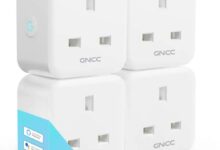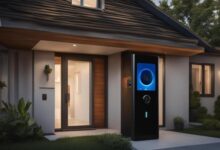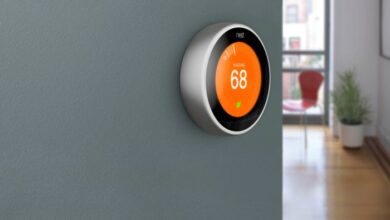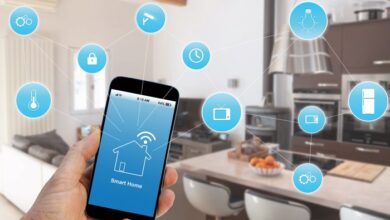Smart Lighting Illuminate Your World
Smart Lighting: It’s more than just a switch. It’s the dawn of a new era in home and commercial illumination, where energy efficiency meets personalized ambiance. Imagine effortlessly adjusting your lighting to match your mood, enhancing security with automated routines, and even saving money on your energy bill – all from your smartphone. This isn’t science fiction; it’s the reality of today’s smart lighting systems, a technology poised to revolutionize how we interact with light.
From the simple elegance of a smart bulb to the sophisticated choreography of a networked lighting system, the possibilities are vast. This deep dive explores the technology behind smart lighting, its myriad benefits, and how it’s transforming homes, businesses, and even public spaces. We’ll unravel the complexities of installation, explore various applications, and peek into the exciting future of this rapidly evolving field.
Defining Smart Lighting
Smart lighting represents a significant advancement in home and commercial illumination, moving beyond simple on/off switches to offer sophisticated control and automation capabilities. This technology leverages interconnected devices and smart home ecosystems to provide a level of customization and energy efficiency previously unimaginable. Understanding its core functionalities is key to appreciating its transformative potential.Smart lighting systems offer several key functionalities.
They allow for remote control of lights via smartphones, tablets, or voice assistants, enabling users to adjust brightness, color temperature, and even create personalized lighting scenes from anywhere with an internet connection. Scheduling features allow for automated on/off times, mimicking occupancy or simulating presence, thereby enhancing security and convenience. Integration with other smart home devices allows for seamless automation, such as lights turning on when a motion sensor detects movement or dimming automatically at sunset.
Energy efficiency is another significant advantage, with many smart bulbs offering dimming capabilities and energy-saving modes.
Types of Smart Bulbs
The market offers a diverse range of smart bulbs, each with its own set of features and benefits. The most common type is the LED smart bulb, known for its energy efficiency, long lifespan, and vibrant color rendering. These bulbs are available in various shapes and sizes to suit different fixtures. While less common now, some manufacturers still produce incandescent smart bulbs, although these are generally less energy-efficient than their LED counterparts.
The choice between LED and incandescent depends largely on individual preferences and existing fixture compatibility. Consider the energy efficiency, color temperature options, and overall cost when selecting smart bulbs for your needs.
Smart Lighting vs. Traditional Lighting
Smart lighting systems offer several advantages over traditional lighting systems. Traditional systems lack the remote control, automation, and energy-saving features inherent in smart lighting. Smart systems provide granular control over lighting, allowing users to tailor the ambiance to their specific needs. Energy savings are significant, as smart bulbs can be dimmed or turned off remotely, reducing overall energy consumption.
The integration capabilities of smart lighting also enhance home security and convenience, features absent in traditional lighting setups. The initial investment in smart lighting may be higher, but the long-term energy savings and added convenience often outweigh the upfront cost.
Smart Lighting Applications
Smart lighting finds applications across a wide range of settings, demonstrating its versatility and impact. In homes, smart lighting enhances ambiance, security, and energy efficiency. Automated lighting schedules can simulate occupancy while homeowners are away, deterring potential intruders. In offices, smart lighting can optimize productivity and improve employee well-being by adjusting lighting levels throughout the day to mimic natural light patterns.
Retail environments benefit from smart lighting by creating engaging and dynamic displays that attract customers and enhance the shopping experience. For instance, a clothing store might use smart lighting to highlight specific items or create themed lighting displays for seasonal promotions. These applications showcase the adaptable nature of smart lighting and its capacity to improve various aspects of daily life.
Smart Lighting Technology
Smart lighting has rapidly evolved from a niche market to a mainstream technology, transforming how we interact with and experience illumination in our homes and workplaces. This transformation is fueled by advancements in several key areas, creating a sophisticated ecosystem of interconnected devices and communication protocols. Understanding these underlying technologies is crucial to appreciating the capabilities and potential of smart lighting systems.Smart lighting leverages a variety of technologies to achieve its functionality, seamlessly integrating into our existing infrastructure and offering a level of control and customization previously unimaginable.
These technologies work in concert, creating a powerful and flexible system capable of adapting to individual needs and preferences.
Underlying Technologies
Smart lighting systems rely on various communication protocols to transmit data between devices. These protocols determine the speed, range, and reliability of the network, influencing the overall user experience. Key technologies include Wi-Fi, Bluetooth, and Zigbee. Wi-Fi, known for its long range and high bandwidth, allows for complex control and integration with other smart home devices. Bluetooth, offering a simpler, lower-power solution, is ideal for controlling individual lights or smaller groups.
Zigbee, a mesh networking protocol, excels in scalability and reliability, making it suitable for larger, more complex systems. The choice of technology often depends on the specific application and desired level of functionality.
Communication Protocols
The effectiveness of a smart lighting system hinges on the seamless communication between its components. Different protocols offer varying advantages and disadvantages. A robust comparison helps in understanding their suitability for specific applications.
| Protocol | Range | Power Consumption | Data Rate | Mesh Networking | Security |
|---|---|---|---|---|---|
| Wi-Fi | Extensive | High | High | No | Moderate |
| Bluetooth | Limited | Low | Moderate | No | Moderate |
| Zigbee | Moderate | Low | Moderate | Yes | High |
Key Components of a Smart Lighting System
A typical smart lighting system comprises several essential components working together. These components interact via the chosen communication protocol, creating a cohesive and controllable lighting environment. Understanding their individual roles is key to effective system design and troubleshooting.The fundamental building blocks are the smart bulbs themselves, which contain the necessary electronics to receive and interpret commands. These bulbs often include features like color temperature adjustment, dimming capabilities, and even integrated speakers.
A central hub acts as a control center, connecting the bulbs to the home network and enabling remote access through a smartphone app or voice assistant. Finally, controllers, such as wall switches or remote controls, provide alternative methods of controlling the lights, offering a more hands-on approach for users who prefer it.
Smart Lighting Network Architecture
The following diagram illustrates a simplified architecture of a smart lighting network. Imagine a central hub, akin to a central nervous system, receiving instructions from a smartphone app or voice assistant. This hub then communicates wirelessly with individual smart bulbs throughout the house, translating commands and ensuring each bulb functions correctly. The system’s scalability allows for the addition of more bulbs and controllers as needed, expanding the network’s reach and capabilities.
The simplicity of the diagram belies the complex interactions occurring behind the scenes, demonstrating the power and efficiency of smart lighting technology.
A well-designed smart lighting network offers a balance between ease of use, scalability, and reliability, providing a seamless and intuitive lighting experience.
Smart Lighting Features and Benefits
Smart lighting offers a compelling blend of convenience, energy efficiency, and enhanced security, transforming homes into more comfortable and secure environments. Beyond simple on/off switches, these systems unlock a wealth of possibilities, impacting everything from energy bills to overall home ambiance. The benefits extend far beyond the initial investment, offering long-term value and a significantly improved living experience.
Energy Efficiency Advantages
Smart lighting systems significantly reduce energy consumption compared to traditional lighting. Their ability to automate lighting schedules, dim lights automatically, and integrate with occupancy sensors allows for precise control over energy usage. For example, a smart bulb can automatically switch off when a room is unoccupied, eliminating wasted energy. This translates to lower electricity bills and a smaller carbon footprint, contributing to a more sustainable lifestyle.
Studies have shown that smart lighting systems can reduce energy consumption by up to 75% depending on usage patterns and system configuration. This reduction is achieved through intelligent control and optimization of lighting based on real-time needs, unlike traditional lighting that remains constantly on.
Impact on Home Security and Safety
Smart lighting enhances home security through features like automated scheduling and remote control. By simulating occupancy even when the house is empty, smart lights deter potential intruders. Imagine setting your lights to turn on and off at various times throughout the evening, creating the illusion of someone being home. This is a powerful deterrent, significantly reducing the risk of break-ins.
Furthermore, integrated security systems allow for immediate alerts in case of unusual activity, enhancing overall safety and peace of mind. For instance, a smart security system can trigger lights to flash brightly if a motion sensor detects movement in a designated area.
Smart Lighting Integration with Other Smart Home Devices
The true power of smart lighting lies in its seamless integration with other smart home devices. This interconnectivity creates a cohesive and automated home environment. For example, smart lighting can be linked to smart speakers, allowing voice control over lighting settings. Integration with smart thermostats enables energy-efficient lighting schedules coordinated with temperature adjustments. Similarly, integration with motion sensors allows for automatic lighting based on occupancy, optimizing energy use and convenience.
Consider a scenario where your smart lighting system automatically dims the lights at sunset, simultaneously adjusting the thermostat to a more comfortable temperature, all controlled through a central smart home hub.
Enhancing Ambiance and Mood with Color and Brightness Control
Smart lighting goes beyond simple illumination; it allows for precise control over color temperature and brightness, transforming the atmosphere of any room. Adjusting the color temperature from cool white for daytime productivity to warm white for a relaxing evening creates a dynamic and personalized environment. Furthermore, the ability to choose from a spectrum of colors enables the creation of specific moods, from vibrant and energetic to calming and serene.
For example, a soft blue light can promote relaxation before bedtime, while a bright yellow light can energize a workspace. This level of control allows users to tailor their lighting to match their activities and emotional state.
Benefits for Different User Groups
Smart lighting offers unique benefits tailored to various user groups.
- Elderly: Improved safety through automated lighting, reducing fall risks in dimly lit areas, and enhanced visibility for better navigation. This can lead to increased independence and a higher quality of life.
- Families with Young Children: Automated nightlights, scheduled lighting changes for bedtime routines, and color-changing capabilities for playful engagement. This adds a layer of convenience and helps establish consistent routines.
- Individuals with Disabilities: Voice-activated control and customizable settings cater to diverse needs and preferences, promoting accessibility and independent living.
Smart Lighting Installation and Setup
Transforming your home into a smart haven starts with seamless smart lighting installation. This process, while seemingly technical, is surprisingly straightforward with a little guidance. Understanding the steps involved ensures a smooth transition to automated, energy-efficient illumination, maximizing your investment and enhancing your living experience.
Basic Smart Lighting System Installation
Installing a basic smart lighting system typically involves replacing existing light bulbs with smart bulbs. Begin by switching off the power to the light fixture at the circuit breaker. Carefully unscrew your existing bulb and replace it with the smart bulb, ensuring a secure fit. Then, restore power to the fixture. The exact process may vary slightly depending on the type of fixture (e.g., recessed lighting may require different procedures), so always consult the instructions provided with your specific smart bulbs.
Connecting Smart Bulbs to a Home Wi-Fi Network, Smart Lighting
Connecting your new smart bulbs to your home Wi-Fi network is the next crucial step. Most smart bulbs utilize a mobile application provided by the manufacturer. Download the app, create an account (if needed), and follow the in-app instructions. These typically involve placing the bulb within range of your Wi-Fi router, activating pairing mode on the bulb (often by switching it on and off repeatedly), and then allowing the app to search for and connect to the bulb.
The app will guide you through selecting your Wi-Fi network and entering your password. Successful connection is usually confirmed within the app. Remember, a strong Wi-Fi signal is essential for reliable performance. A weak signal can lead to connectivity issues and slow response times.
Troubleshooting Common Smart Lighting Installation Issues
Despite the simplicity of the process, some common issues may arise. For example, if the bulb isn’t detected by the app, ensure it’s within range of your Wi-Fi router and that the bulb is correctly screwed into the socket. Check your Wi-Fi password accuracy and ensure your router is functioning correctly. If your bulb is connected but not responding, try restarting both the bulb and your Wi-Fi router.
Power cycling the entire system often resolves temporary glitches. If problems persist, consult the manufacturer’s troubleshooting guide or contact their customer support. Remember, patience is key. Some setups require multiple attempts.
Smart Lighting System Setup Checklist
A checklist helps streamline the process and minimizes potential problems. Before you begin, ensure you have the necessary tools (such as a ladder if needed) and that your smart bulbs are compatible with your Wi-Fi network (check frequency – 2.4 GHz is most common). Download the manufacturer’s app beforehand. After installation, verify the connection by controlling the bulb via the app.
Finally, explore the app’s features to personalize your lighting settings. A well-organized checklist ensures a smoother and more efficient setup.
Compatible Devices, Installation Steps, Troubleshooting, and Warranty Information
| Smart Lighting Brand | Compatible Devices | Installation Steps | Troubleshooting Tips | Warranty Information |
|---|---|---|---|---|
| Philips Hue | Various bulbs, switches, and accessories; compatible with Apple HomeKit, Google Assistant, and Amazon Alexa | Download Hue app, screw in bulb, connect to Wi-Fi via app | Check Wi-Fi signal strength, restart router and bulbs, consult Hue app troubleshooting | Typically 2 years |
| LifX | Wide range of bulbs with various color temperatures and effects; works with Apple HomeKit, Google Assistant, and Amazon Alexa | Download LifX app, screw in bulb, connect to Wi-Fi via app | Check Wi-Fi signal strength, ensure bulb is properly seated, reset bulb if necessary | Typically 1 year |
| IKEA Trådfri | Bulbs, light panels, and remotes; works with Apple HomeKit, Google Assistant, and Amazon Alexa | Download IKEA Home smart app, screw in bulb, connect to Wi-Fi via app or gateway | Check Wi-Fi signal strength, ensure gateway is properly connected, reset gateway or bulb if needed | Typically 1 year |
Smart Lighting Applications and Use Cases
Smart lighting’s impact extends far beyond simple illumination; it’s a transformative technology reshaping how we interact with our environments, from boosting energy efficiency in commercial spaces to enhancing the customer experience in retail settings. Its adaptable nature allows for customized solutions across various sectors, optimizing both functionality and aesthetics.Smart lighting systems offer a compelling blend of convenience, efficiency, and aesthetic control, making them invaluable across diverse applications.
Their ability to adapt to changing needs and preferences makes them a powerful tool for businesses and individuals alike.
Energy Management in Commercial Buildings
Implementing smart lighting in commercial buildings presents a significant opportunity for substantial energy savings. By leveraging occupancy sensors, daylight harvesting, and automated scheduling, businesses can dramatically reduce their energy consumption. For instance, a large office complex could see a 30-40% reduction in lighting energy costs by integrating smart lighting controls that automatically dim or switch off lights in unoccupied areas.
This translates to significant cost savings and a smaller carbon footprint. Advanced systems can even analyze energy usage patterns to further optimize performance and predict maintenance needs. The return on investment (ROI) for such systems is often realized within a few years, justifying the initial implementation costs.
Dynamic Retail Environments
In the retail sector, smart lighting transforms the shopping experience. The ability to adjust lighting color temperature and intensity creates dynamic environments that enhance product displays and influence customer behavior. Imagine a clothing store using warm, inviting lighting to showcase evening wear, shifting to cooler tones during the day to highlight brighter summer collections. This targeted approach to lighting can increase sales conversions and create a more engaging atmosphere.
Furthermore, smart lighting can be synchronized with other technologies, such as digital signage and music, to create a fully immersive and personalized shopping experience. Data analysis from smart lighting systems can also provide valuable insights into customer traffic patterns and preferences.
Productivity and Well-being in Office Spaces
Smart lighting plays a crucial role in improving workplace productivity and employee well-being. Studies have shown that proper lighting can reduce eye strain, headaches, and fatigue, leading to increased focus and efficiency. By incorporating human-centric lighting, which mimics natural daylight patterns, offices can create a more comfortable and stimulating environment. This includes adjusting color temperature and intensity throughout the day to align with the natural circadian rhythm, promoting alertness during working hours and facilitating relaxation at the end of the day.
The result is a more productive and healthier workforce. Companies are increasingly recognizing the positive impact of such investments on employee morale and retention.
Creative Applications in Art Installations and Architectural Design
Smart lighting transcends mere functionality, becoming an integral element in artistic expression and architectural design. Imagine a museum installation where LED lights dynamically illuminate sculptures, changing colors and intensity to emphasize specific details or evoke particular emotions. For example, a retrospective of a famous painter could use lighting to highlight brushstrokes and color palettes, shifting hues subtly to guide the viewer’s eye through the artist’s evolution.
In architectural design, smart lighting can transform buildings into dynamic canvases, creating mesmerizing light shows or subtly changing the ambiance of a space. The possibilities are limited only by imagination and technological innovation. A recent museum exhibit used smart lighting to project changing constellations onto the ceiling, creating an immersive and awe-inspiring experience for visitors. The lighting effects subtly changed throughout the evening, creating a sense of movement and mystery, perfectly complementing the theme of the exhibit.
Future Trends in Smart Lighting
Smart lighting is rapidly evolving, driven by advancements in technology and a growing focus on sustainability. The integration of artificial intelligence, the pursuit of energy efficiency, and the expansion of smart home ecosystems are shaping the future of how we illuminate our lives, both at home and in commercial spaces. This evolution promises not only greater convenience but also significant environmental benefits and cost savings.
Emerging Technologies in Smart Lighting
Several technological advancements are poised to revolutionize smart lighting. LiFi, a wireless communication technology using light waves instead of radio waves, offers significantly higher bandwidth and security compared to Wi-Fi, paving the way for faster data transmission and more responsive lighting systems. Furthermore, advancements in organic light-emitting diode (OLED) technology are producing more energy-efficient and flexible lighting solutions, allowing for innovative designs and seamless integration into various surfaces.
The integration of microLEDs promises even higher resolution and improved color accuracy, leading to a more immersive and customizable lighting experience. Finally, the development of advanced materials, such as self-healing polymers, could lead to more durable and long-lasting smart lighting fixtures.
Artificial Intelligence and Machine Learning in Smart Lighting
AI and machine learning are transforming smart lighting systems by enabling more personalized and adaptive lighting experiences. AI-powered algorithms can learn user preferences, such as preferred brightness levels and color temperatures at different times of the day, and automatically adjust lighting accordingly. This level of automation not only enhances convenience but also optimizes energy consumption. Machine learning algorithms can also predict equipment failures and proactively schedule maintenance, minimizing downtime and extending the lifespan of lighting systems.
For example, imagine a smart lighting system that learns your sleep patterns and automatically dims the lights in your bedroom at your usual bedtime, contributing to a more restful night’s sleep while conserving energy. Similarly, predictive maintenance algorithms could alert you to a potential bulb failure weeks in advance, allowing for a timely replacement and avoiding unexpected darkness.
Smart Lighting and Sustainable Environments
Smart lighting plays a crucial role in creating sustainable and energy-efficient environments. By utilizing energy-efficient LED technology and incorporating smart controls, significant reductions in energy consumption can be achieved. Smart lighting systems can automatically adjust lighting levels based on occupancy, ambient light conditions, and even time of day, eliminating wasted energy from unnecessarily bright or constantly illuminated spaces.
The integration of smart sensors can further optimize energy usage by detecting and responding to changes in the environment. Consider a large office building employing a smart lighting system that automatically dims lights in unoccupied rooms and adjusts brightness based on natural daylight availability. This results in substantial energy savings and a reduced carbon footprint. Furthermore, the use of smart lighting can contribute to a reduction in light pollution, which has significant positive impacts on both wildlife and human health.
Future of Smart Home Lighting Integration and Control
The future of smart home lighting points towards seamless integration with other smart home devices and improved control systems. Voice control, already widely adopted, will become even more sophisticated, allowing for more nuanced control over lighting scenarios. Integration with other smart home systems will enable complex automation routines, such as coordinating lighting with security systems, climate control, and entertainment systems.
For example, a smart home system could automatically turn on the lights in the hallway when the security system detects movement, or dim the lights and play relaxing music when you initiate a “relaxation” mode on your smart home hub. Furthermore, advancements in user interfaces will simplify control and customization, making smart lighting accessible and intuitive for a wider range of users.
The overall trend is towards a more personalized, responsive, and intuitive lighting experience that seamlessly blends with the overall smart home ecosystem.
Wrap-Up
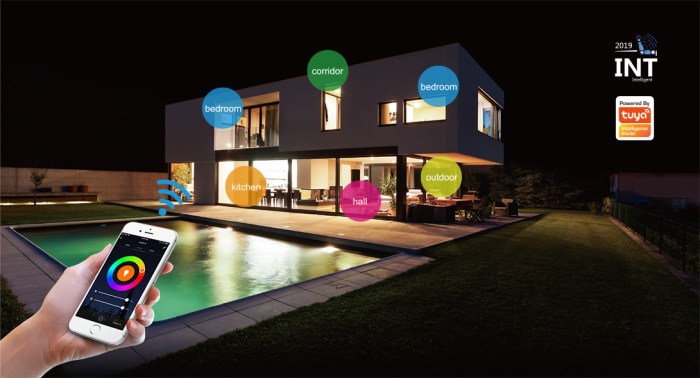
Smart lighting isn’t just about brighter bulbs; it’s about creating smarter, more efficient, and more personalized environments. Whether you’re seeking energy savings, enhanced security, or simply a more captivating atmosphere, smart lighting offers a compelling solution. As technology continues to advance, expect even greater levels of integration, customization, and convenience, ushering in a future where light is truly intelligent and responsive to our every need.
Embrace the illumination – the future is bright.

